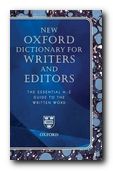difficult cases of spellings and expressions
The Dictionary for Writers and Editors has been ‘repurposed’ from its original larger-scale edition to sit alongside the New Oxford Spelling Dictionary, New Hart’s Rules, and the Oxford BBC Guide to Pronunciation. These form a group of new reference sources for writers and editors who are concerned with preparing texts for publication to the highest possible standard. It’s a specialist dictionary for writers, journalists, and text-editors. It offers rulings on words and spellings which are commonly problematic.
 For instance, do we write Muslim or Moslem, customise or customize? It covers the names of well-known people and places, foreign words and commonly-used phrases such as petit-bourgeois and persona non grata. Entries run from A as a letter or paper size to Zydeco music and Zyklon B.
For instance, do we write Muslim or Moslem, customise or customize? It covers the names of well-known people and places, foreign words and commonly-used phrases such as petit-bourgeois and persona non grata. Entries run from A as a letter or paper size to Zydeco music and Zyklon B.
Many of these items are in any good dictionary, but this one eliminates all the non-problematic words and makes the book easier to use. It also deals with abbreviations, capitalization and punctuation. I looked up amendment [one ‘m’] superseded [yes – it’s spelt with an ‘s’] and manageable [it keeps the ‘e’]. It can also be used as a quick guide to many niceties of writing (the difference between hyphens and dashes) and as a potted source for historical names, dates, and places of importance.
At first glance, there might not seem much difference between this and an ordinary dictionary, but the process of selection and the emphasis on explanations of common problems makes it a very useful resource. This latest edition offers a huge revision and update on the original. Entries have been expanded on doubtful or variable spellings (“gettable” not “getable”); the punctuation of dates and spellings of proper names; and all those other little things that are so difficult to be consistent about when writing. It is also an invaluable guide to words that are often confused such as biannual (twice every year, or every six months) and biennial (every two years).
It is designed to be used in conjunction with New Hart’s Rules, which gives details of how text should be edited in preparation for printing. The headword is set in bold sans-serif, which makes it more immediately legible, though it might seem strange if you are used to the OUP tradition of bold Roman. There are four appendices: mathematical and logical symbols; proofreading marks; a list of diacritical accents; and tables for transliterating Arabic, Hebrew, Greek, and Russian.
It should certainly be amongst the reference tools of anybody who takes a serious interest in writing. The new smaller handbook format is a matter of personal taste, but it certainly looks a handsome little tome flanked by its three cousins.
© Roy Johnson 2005
The Oxford Dictionary for Writers and Editors, Oxford: Oxford University Press, 2005, pp.434, ISBN: 0198610408
More on language
More on literary studies
More on writing skills
More on creative writing
More on grammar